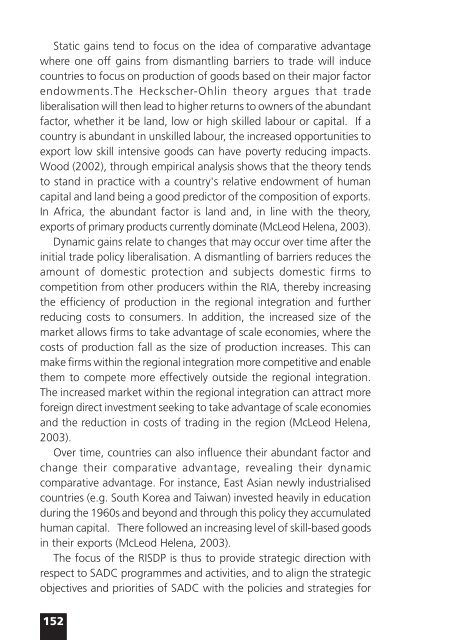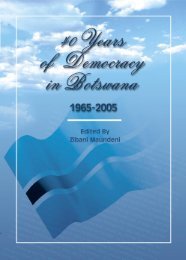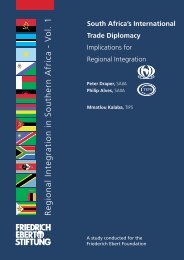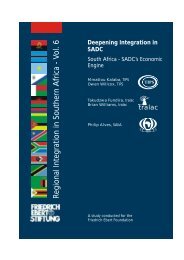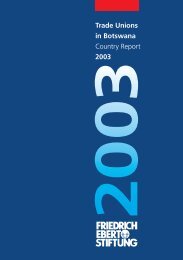Deepening Integration in SADC - Fes-botswana.org
Deepening Integration in SADC - Fes-botswana.org
Deepening Integration in SADC - Fes-botswana.org
You also want an ePaper? Increase the reach of your titles
YUMPU automatically turns print PDFs into web optimized ePapers that Google loves.
Static ga<strong>in</strong>s tend to focus on the idea of comparative advantage<br />
where one off ga<strong>in</strong>s from dismantl<strong>in</strong>g barriers to trade will <strong>in</strong>duce<br />
countries to focus on production of goods based on their major factor<br />
endowments.The Heckscher-Ohl<strong>in</strong> theory argues that trade<br />
liberalisation will then lead to higher returns to owners of the abundant<br />
factor, whether it be land, low or high skilled labour or capital. If a<br />
country is abundant <strong>in</strong> unskilled labour, the <strong>in</strong>creased opportunities to<br />
export low skill <strong>in</strong>tensive goods can have poverty reduc<strong>in</strong>g impacts.<br />
Wood (2002), through empirical analysis shows that the theory tends<br />
to stand <strong>in</strong> practice with a country's relative endowment of human<br />
capital and land be<strong>in</strong>g a good predictor of the composition of exports.<br />
In Africa, the abundant factor is land and, <strong>in</strong> l<strong>in</strong>e with the theory,<br />
exports of primary products currently dom<strong>in</strong>ate (McLeod Helena, 2003).<br />
Dynamic ga<strong>in</strong>s relate to changes that may occur over time after the<br />
<strong>in</strong>itial trade policy liberalisation. A dismantl<strong>in</strong>g of barriers reduces the<br />
amount of domestic protection and subjects domestic firms to<br />
competition from other producers with<strong>in</strong> the RIA, thereby <strong>in</strong>creas<strong>in</strong>g<br />
the efficiency of production <strong>in</strong> the regional <strong>in</strong>tegration and further<br />
reduc<strong>in</strong>g costs to consumers. In addition, the <strong>in</strong>creased size of the<br />
market allows firms to take advantage of scale economies, where the<br />
costs of production fall as the size of production <strong>in</strong>creases. This can<br />
make firms with<strong>in</strong> the regional <strong>in</strong>tegration more competitive and enable<br />
them to compete more effectively outside the regional <strong>in</strong>tegration.<br />
The <strong>in</strong>creased market with<strong>in</strong> the regional <strong>in</strong>tegration can attract more<br />
foreign direct <strong>in</strong>vestment seek<strong>in</strong>g to take advantage of scale economies<br />
and the reduction <strong>in</strong> costs of trad<strong>in</strong>g <strong>in</strong> the region (McLeod Helena,<br />
2003).<br />
Over time, countries can also <strong>in</strong>fluence their abundant factor and<br />
change their comparative advantage, reveal<strong>in</strong>g their dynamic<br />
comparative advantage. For <strong>in</strong>stance, East Asian newly <strong>in</strong>dustrialised<br />
countries (e.g. South Korea and Taiwan) <strong>in</strong>vested heavily <strong>in</strong> education<br />
dur<strong>in</strong>g the 1960s and beyond and through this policy they accumulated<br />
human capital. There followed an <strong>in</strong>creas<strong>in</strong>g level of skill-based goods<br />
<strong>in</strong> their exports (McLeod Helena, 2003).<br />
The focus of the RISDP is thus to provide strategic direction with<br />
respect to <strong>SADC</strong> programmes and activities, and to align the strategic<br />
objectives and priorities of <strong>SADC</strong> with the policies and strategies for<br />
152


